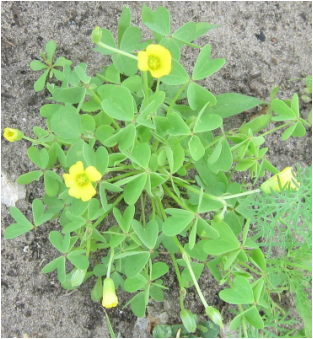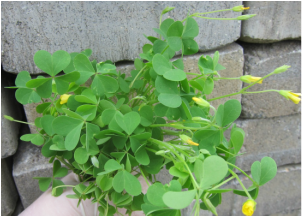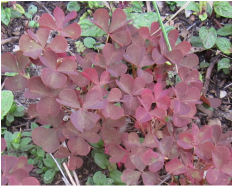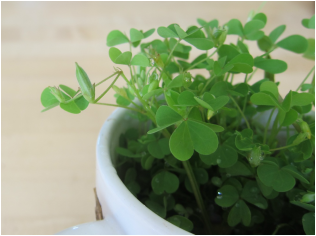The oxalis is a pretty little weed. Its name, “Oxalis” comes from the Greek word oxus meaning “sour.” There are about 850 widely varying species of this ubiquitous little plant which is found on every continent except Antarctica. Some varieties grow from tubers, some from bulbs, some have rhizomes and some spread seeds. Some are grown in pots as houseplants, others have been cultivated for their tubers as an alternative to potatoes, but most are just considered to be weeds.

The oxalis variety that grows in my yard and garden is known as the common yellow wood sorrel, Oxalis stricta. It is also called yellow oxalis, sour grass, and sheep's clover. Ironically, the common yellow wood sorrel is not related to the sorrel family at all. The only connection to sorrels is that they are sour because of the oxalic acid they contain, like sorrels.
This yellow wood sorrel is a tender perennial which may spread by means of rhizomes (underground stems) but more commonly it just grows as an annual, reseeding itself every year. It prefers moist soil and partial shade but, like most weeds, it is tolerant of a wide range of conditions and can be found in meadows, in woods, in lawns, along roadsides, even in the cracks of sidewalks -- any area where the soil has been disturbed. Like most weeds it is very adaptable and prolific. If left uncut, the yellow oxalis can grow as tall as a foot.
This yellow wood sorrel is a tender perennial which may spread by means of rhizomes (underground stems) but more commonly it just grows as an annual, reseeding itself every year. It prefers moist soil and partial shade but, like most weeds, it is tolerant of a wide range of conditions and can be found in meadows, in woods, in lawns, along roadsides, even in the cracks of sidewalks -- any area where the soil has been disturbed. Like most weeds it is very adaptable and prolific. If left uncut, the yellow oxalis can grow as tall as a foot.

The most recognizable characteristic of the oxalis is its leaves. Each leaf is divided into three leaflets similar to a clover...but they are not related to the clover family, either. The oxalis leaflets are heart-shaped rather than round like the clovers and the leaves close up at night, during storms or when picked. Some oxalis varieties are sold as shamrocks and many believe it was an oxalis that St. Patrick used to illustrate the Trinity. However, there are many plants vying this claim; no one knows for sure what plant St. Patrick used or even if he used a plant at all. Most oxalis plants are green, but some have are purple or maroon cast.

Buds, flowers and seedpods can all be found on the same plant throughout the summer and the leaves, flowers, roots and seedpods are all edible, either raw or cooked. It’s is easy to identify, and fortunately there is no similar looking plant that might be harmful to eat.
True to the name, oxalis has a sour flavor; some claim it is ‘lemony.’ They can be added to salads, soups, or sauces, or used as a seasoning. One person even suggested adding oxalis leaves to fruit pies such apple or peach. Since I like the pies the way they are I didn't want to risk an entire pie trying this idea.
True to the name, oxalis has a sour flavor; some claim it is ‘lemony.’ They can be added to salads, soups, or sauces, or used as a seasoning. One person even suggested adding oxalis leaves to fruit pies such apple or peach. Since I like the pies the way they are I didn't want to risk an entire pie trying this idea.

As a seasoning, it provides a tart lemon or vinegar taste. The plant juices can even be used as a substitute as vinegar or to curdle milk when making cheese. One common suggestion is to stuff fresh fish with oxalis to add a lemony flavor. Fortunately, there is probably a patch near every campsite or fishing stream.

The leaves can be steeped in boiling water for 5-10 minutes and then sweetened to make a drink that some claim is similar to lemonade. Recipes for this drink vary. Some suggest pouring hot water over the leaves to steep the tea. Others suggest boiling them for 5-10 minutes. They all agreed that it needs to be sweetened, however. I boiled leaves about 1 cup of leaves in 3 cups of water for 10 minutes trying to get the most flavor. With a lot of imagination a person might think there is a hint of lemon…but mostly it tasted like weird water. Maybe I needed more sugar.
As with most sour vegetables, oxalis very high in Vitamin C but, like many greens, such as spinach, Swiss chard, beet greens, sorrel, parsley, and rhubarb and weeds such as purslane and lambs quarter, the leaves contain oxalic acid (the source of the sour flavor). Oxalic acid is fine in a decent amounts, but large quantities of oxalic acid will bind calcium and prevent the body from absorbing it. Some say it can even cause calcium to leech from the bones. Because of the danger of inhibiting calcium absorption, people with kidney stones, gout and arthritis may want to avoid all plants with oxalic acid.
As with most sour vegetables, oxalis very high in Vitamin C but, like many greens, such as spinach, Swiss chard, beet greens, sorrel, parsley, and rhubarb and weeds such as purslane and lambs quarter, the leaves contain oxalic acid (the source of the sour flavor). Oxalic acid is fine in a decent amounts, but large quantities of oxalic acid will bind calcium and prevent the body from absorbing it. Some say it can even cause calcium to leech from the bones. Because of the danger of inhibiting calcium absorption, people with kidney stones, gout and arthritis may want to avoid all plants with oxalic acid.
|
Oxalis Cooler
1 quart water 1 Tbsp honey dash of salt ½ cup oxalis (leaves, stems, flowers and seedpods — the entire plant) Blend together in a blender. Refrigerate overnight. Wood Sorrel Sauce 2 cups wood or sheep sorrel leaves 2 Tbsp butter or olive oil Heat butter or oil over low heat in a medium pot. Add the leaves and stir until they are wilted Serve with seafood or vegetables or add to soup, anywhere you want a tart, lemony flavor. |


